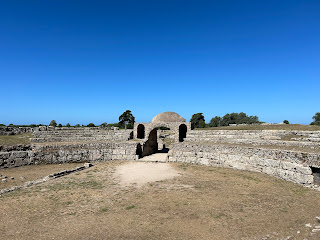Greek temples in Italy? If you need confirmation as to how crazy the world can be, visit Italy where you'll find more Greek temples than in Greece.
Historians in the know report that during the eighth century BC, ancient Greeks settled along the coasts of the Mediterranean Sea and founded more than 500 Greek colonies, scattered along the shores of the Black Sea, southern Italy, Northern Africa and the coasts of southern France and Spain. They built temples to honor their gods.
We wanted to see for ourselves what historians call a miracle.
Sure enough--for some unexplained reason, the Romans did not destroy three well-preserved Greek temples. Centuries later, the miracle continued. During WWII, American (136th Infantry Division) and British forces arrived to liberate Italy. Salerno was the landing point where the Americans fought the Germans for control. The American soldiers slept in those same temples. The fighting caused some damage, but still the temples survived.
They are a marvel. When you first see them, they seem surreal--as if you've stepped back in time. Imagine a field of grass and rock and dirt, where larger stones lay on top. This is what excavation looks like, a slow process of uncovering what lies beneath. Paestum is approximately one half mile wide. So far, the Italians have excavated only one fifth of that area:
In the distance you see a stone archway.
Further on, you spot your first temple. Doric style. Built in honor of Hera, one of the Greek gods, in 600 BC. Paestum thrived as a democracy for 200 years.
To the left is the second temple built in honor of Hera. Again remarkably well-preserved.
I'm not an expert on temples, but even I can see the details that remain after thousands of years. It is truly remarkable.
Theo is with us, of course. He loves being outside, smelling the breezes. Today is not as hot as it usually is in Italy in June. But Theo loves the sun. He seems as entranced as we are.
You can get up close and personal to these two temples, which isn't always the case when you visit ruins. (You can only admire the Acropolis in Athens, Greece, from afar.) Here you can climb up and walk inside the temple and touch the stone. You can imagine the awe the peasants would have felt to witness the size and glory of a building.
Theo is having the time of his life. I suspect things are only real to him if he can sniff them. After a few minutes, we have to usher him along. There is still one more temple to see. And the amphitheater.
The third temple (far to the right) is dedicated to Athena. Unfortunately, barriers are erected to keep tourists from going inside. What happens next is our own darned fault.
Theo thinks you can sniff any ruin. Any temple. He doesn't quite get the context of barriers which means keep out. A barrier is just an obstacle that he can easily overcome. In this case, he slides through and is standing in the forbidden zone.
This is going to be tricky.
"What do you think we should do?"
Now the barriers are not ten feet tall. Dan can scoot over one in an instant. We look around. A few people are milling about. A horde of tourists are still over by the Hera Temple. We have a few minutes yet to solve the problem.
"I don't see any guards."
Still Dan is reluctant to go into the forbidden zone. Would Italians think it's cute that we're rescuing our cat or would they see us as temple terrorists and arrest us? I can see the headlines now . . .
"Theo," he calls. "Snack time."
Who says Theo doesn't understand English? Or recognize the sound of his favorite dried food rustling against the small plastic container we're holding.
"Shake it again."
That's all it takes. Theo loses interest in the temple and slides back through the barrier. We hightail it over to the amphitheater and sit down to snack.
As we're leaving, we take one last look behind. The Athena Temple stands there in all its glory, and we're sure it's destined to remain for at least another thousand years.













Theo, Paestum is one of my favorite places - but it can’t compete with SNACKS!!!
ReplyDelete